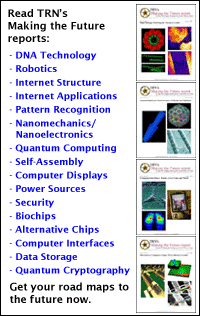
Inkjet prints human cells
By
Eric Smalley,
Technology Research NewsOne of the key tools used in research aimed at growing replacement organs and tissues is the everyday inkjet printer.
The printers have been used to make scaffolds for growing tissue and to spray cells in nutrient-rich liquids onto surfaces. Key challenges are putting the right cells in the right places and ensuring that the cells survive the rough ride.
Researchers from the University of Manchester in England have devised a method that delivers human cells unharmed to chosen locations within polymer scaffolds. "The scaffold is... built from a material designed to degrade in the body and be absorbed over a timescale of months," said Brian Derby, a professor of materials science at the University of Manchester. "While this occurs, the cells multiply and generate tissue to replace the scaffold."
The researchers are working with reconstructive surgeons to put the method to the test by growing tissues to reimplant in the donor, said Derby. "Applications include replacement for bones removed during cancer surgery [and] working with burn victims to regenerate skin," he said. "Because we use the patient's own cells we remove rejection problems with the implants."
The method could also be used to build experimental environments for monitoring the responses of cells to external stimuli, and for building cell-based biosensors, said Derby.
Previous research proved that cow cells can survive inkjet printing. The University of Manchester researchers used human fibroblast and osteoblast cells, which are the cells that form muscle and bone tissue. The cells are forced at high pressure through a 30-micron wide nozzle. A micron is one thousandth of a millimeter. "In an inkjet printer, the drops are generated at extreme shear rates and at accelerations greater than 100g," said Derby. Shear is opposite forces in parallel planes acting on an object. One g is the force of gravity.
The researchers showed that human cells printed into wells containing nutrients could multiply, spread out and form attachments to the surface during a six day incubation period. The researchers used printer driving voltages of 30 and 60 in order to ensure that the velocity was low enough to avoid harming the cells.
The researchers also used an inkjet printer to form a tissue scaffold and to seed the scaffold with cells, said Derby. Ordinarily, tissue scaffolds are immersed in a liquid containing cells. With this setup, however the cells only penetrate a few millimeters, he said. "Our technique allows the seeding of scaffold interiors as they are built," he said.
In addition, the immersion approach can only seed scaffolds with homogenous mixtures of cells, said Derby. The researchers' method provides precise control of cell position, which allows the researchers to deposit different types of cells in different locations, he said.
The researchers are working to allow the method to produce thicker structures, said Derby. "We are currently limited to one or two layers of cells and scaffold," he said.
Moving beyond this requires better temperature control of the substrates and a method for providing nutrient supply during printing, said Derby.
The cell printing technique could be used practically in five to ten years, said Derby.
Derby's research colleagues were Rachel Saunders and Julie Gough of the University of Manchester in England, and Nuno Reis of the University of Manchester and the Institute of Technology (IST) in Portugal. They presented an previous version of the method at the Materials Research Society Fall 2003 meeting held in Boston December 1 through 5. The research was funded by the UK Engineering and Physical Science Research Council (ESPRC) in the UK.
Timeline: 5-10 years
Funding: Government
TRN Categories: Biotechnology; Applied Technology
Story Type: News
Related Elements: Technical paper, "Ink-Jet Printing of Human Cells," Materials Research Society Fall 2003 meeting, Boston, December 1-5, 2003
Advertisements:
March 23/30, 2005
Page One
Stories:
Tool turns English to code
Common sense boosts speech software
Inkjet prints human cells
How it Works: Biochips
Briefs:
Nanowires track molecular activity
Microdroplet makes mighty microscope
Cheap material makes speedy memory
Tiny crystals adjust laser colors
Electricity controls biomolecules
Nanotubes juice super batteries
Layers promise cheap circuits
News:
Research News Roundup
Research Watch blog
Features:
View from the High Ground Q&A
How It Works
RSS Feeds:
News
Ad links:
Buy an ad link
| Advertisements:
|
 |
Ad links: Clear History
Buy an ad link
|
TRN
Newswire and Headline Feeds for Web sites
|
© Copyright Technology Research News, LLC 2000-2006. All rights reserved.